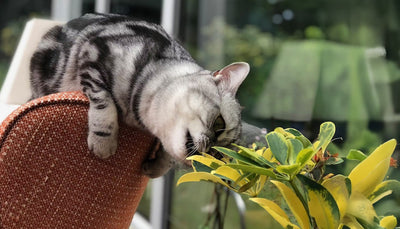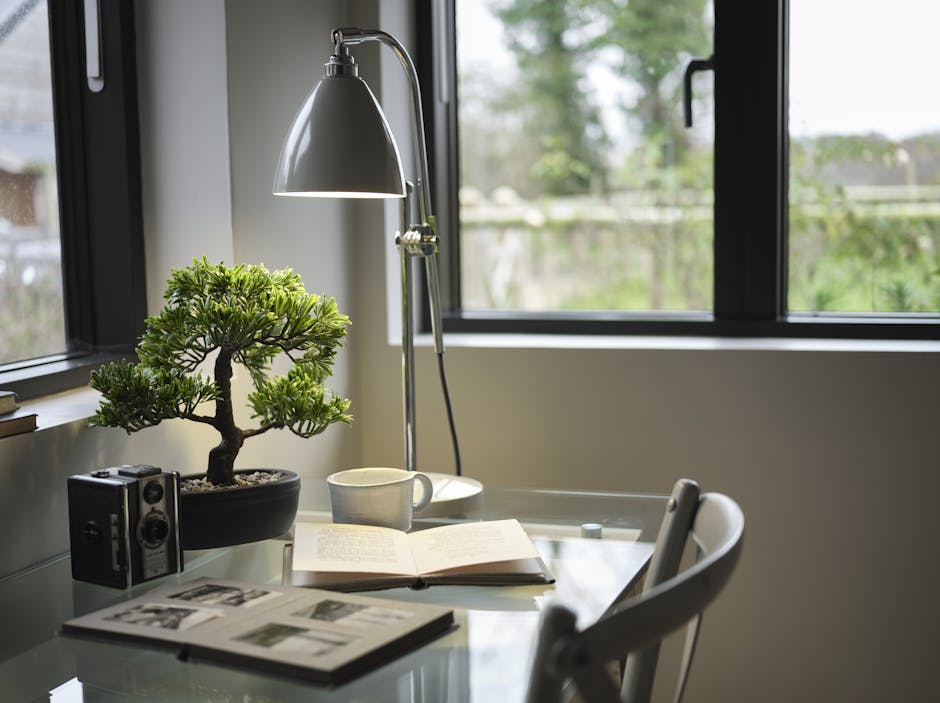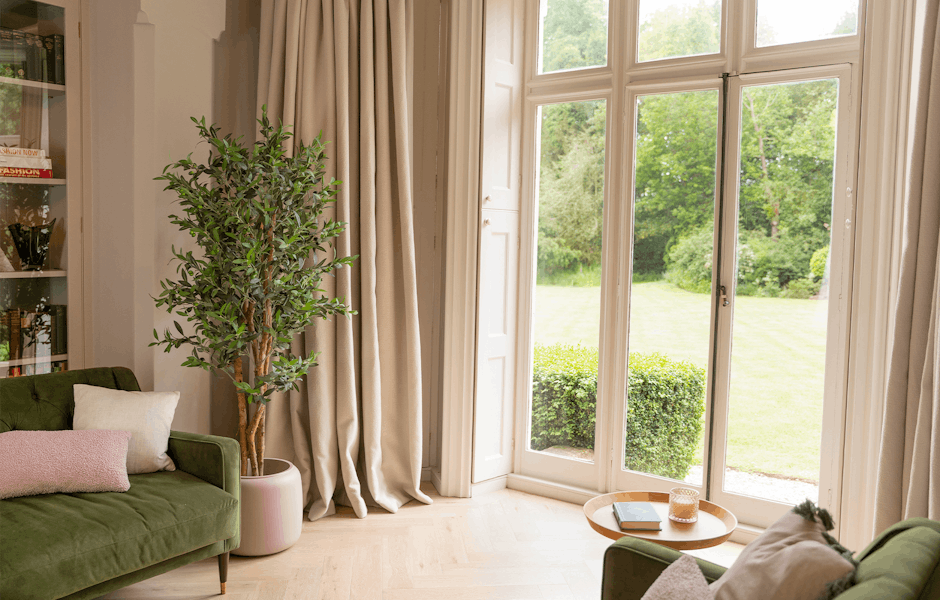
It’s beginning to look a lot like Christmas! Without a needle on the floor, our Christmas collection is here to bring instant, easy and unbelievably beautiful colour this festive season.

We often choose houseplants based on style, but maintenance is just as important when choosing a houseplant to suit your routine and skill level.
Sadly, the most popular houseplants aren’t always the easiest to look after - worsening allergies, posing a threat to pets, and possessing a long list of maintenance demands.
Faux plants, on the other hand, give you all the beauty and colour without the work. New technology means that they’re more realistic than ever, so it’s easy to pull off the look. Plus there’s no watering, pruning, sunlight or soil needed - just easy, low-maintenance beauty. Ideal for anyone who wants plants without the hassle!
Below we’ll talk about the 10 most difficult houseplants to care for - from challenging olive trees and fussy calatheas to more temperamental varieties - including the differences between their faux alternatives.

At the top of our list for good reason! Orchids are the ultimate plant divas with a long list of requirements.
If you manage to nail the conditions just right, these beauties can actually be quite low maintenance. The catch? Achieving those ideal conditions in a typical UK home is easier said than done.
Most orchids hail from tropical climates, which already spells trouble when faced with the UK’s wet and windy weather. And let's not forget that an orchid isn’t just an orchid. There are thousands of species out there, each needing different care routines.
Take the phalaenopsis orchid for example. It's one of the most popular orchids, likely because it’s also one of the easiest to care for, but its care routine isn’t overly friendly for new plant parents.
Moth orchids need a consistently warm environment all year round with bright, but not strong light, usually on an east or west-facing windowsill.
 Calatheas are beautiful exotic plants bearing a variety of striking patterns which make them popular for those after something a little different. As always though, their beauty comes at a price.
Calatheas are beautiful exotic plants bearing a variety of striking patterns which make them popular for those after something a little different. As always though, their beauty comes at a price.
Just like orchids, calatheas are tropical, which means they crave a warm, humid space to lay out their leaves with plenty of bright, indirect sunlight. That means no draughts, no cold, dark rooms and plenty of misting to provide ample humidity.
A bright and warm bathroom is their idea of paradise - but let’s be real, when you work this hard to maintain a calathea, you’ll want to show off its dramatic foliage in a more prominent part your home like your living room, where it can be much harder to achieve these conditions.
And whatever you do, don’t give it tap water! These fussy plants need distilled, filtered or rainwater to stay alive.
Calatheas can be just as dramatic as their leaves, but they’re also some of the most beautiful desktop plants which come in all shapes and sizes. From rattlesnake and pinstripe varieties, each has its own unique patterns and colours, ranging from deep purples to iridescent greens.
Keep in mind that each species may have slightly different needs, so be sure to do your homework before making it a part of your family. And if you’d rather, we have a glorious gang of faux calatheas waiting to steal the show without any bother.

Another tropical favourite! Alocasias saw a boom in popularity back in the 1950’s and their waxy, patterned leaves are a favourite among vintage interior lovers today.
We love using them as interesting table plants where they can bring a certain warmth and a vintage vibe to your home, but they also work brilliantly in bathrooms and as floor plants once they get bigger.
As with most in our list, alocasias are water snobs and will turn their noses up at tap water, especially in hard water areas. And while they love water, they don’t like too much – it's all a balancing act.

The soft, rounded leaves of the fiddle leaf fig make it brilliant for injecting a splash of soothing colour to your bedroom or bathroom. Plus, its simple greenery can blend effortlessly into about interior!
While fiddle leaf figs are slightly more forgiving for beginners than an alocasia or calathea, that doesn’t mean that they’re hassle-free.
The part that most people get wrong with this plant is overwatering. While the fiddle leaf fig tree is a rainforest plant and loves humidity, many people make the mistake of thinking that it needs plenty of water.
 These miniature trees sure do look cool, but they come with extra baggage. Becoming a bonsai master requires extra care, not to mention an abundance of patience and dedication.
These miniature trees sure do look cool, but they come with extra baggage. Becoming a bonsai master requires extra care, not to mention an abundance of patience and dedication.
Technically any tree can be made into a bonsai, so you can imagine how many varieties there are to care for, all suited to different environments and needing different levels of care.

Polka dot plants come in a variety of vibrant colours and patterns - the freckle face variety being particularly adored by fans of rare and unusual houseplants.
If you’re thinking of adding one to your plant family (or if you already own one) brace yourself for drama, as these plants are big attention seekers and like to make it known when they’re unhappy.
For beginner gardeners, snipping off leaves and branches can be rather daunting, but polka dot plants love it. In fact, they demand that their branches be neatly clipped back, and you’d better oblige if you have any hope of keeping one happy. 🤞
Without plenty of light, water, humidity and a good trim, these hard to please plants will grow pale and leggy before seizing to exist altogether, so you’d best be prepared to put in the work if you want to enjoy their stunning patterned leaves.

Despite being one of the most popular indoor plants, their Mediterranean origins make olive trees one of the trickiest houseplants to own.
Olive trees are typically grown in sun-soaked Italy, Greece and other parts of the Mediterranean where they get hours of full sunlight. When grown indoors in the UK, they just can’t get the same amount of sunlight that they enjoy, which is why lots of us struggle to keep them happy.
If you choose to keep an olive tree as a houseplant, your best bet is to keep it in the sunniest part of your home, where it’ll get the most light and warmth. A conservatory is a great place during the summer, just make sure to move it to a warmer spot come winter.

The Boston fern can be a tricky beast to tackle. These gorgeous green ferns would naturally grow in humid swamps and forests in Central America and Africa – totally different to a home in the UK! Over here, they're one of the worst plants for the bedroom, as their spores can worsen allergies and asthma.
You’ll find yourself having to mist your Boston fern constantly to achieve the level of humidity it likes, and even then, it’ll almost definitely drop its leaves and leave them a mess on the floor for your cat to chew on later.
If this wasn’t enough, many owners are tricked into thinking that as a tropical plant, it’ll enjoy lots of bright sunlight, which is often their downfall! Instead, Boston ferns enjoy partial shade as they’re prone to sun-scorched leaves.

The trendy monstera plant makes a brilliant floor plant, with beautiful glossy foliage that add big leafy colour to your space. They also make excellent trailing plants, cascading down a shelf with style.
While monsteras can tolerate a bit of shade and are great for lower-light spaces, they won’t show off those signature holes (fenestrations) in their leaves unless they get some bright, indirect light. They also love humidity and enjoy temperatures between 18°C - 30°C.
The monstera is a natural climber which can grow several feet a year and become rather bushy, so you’ll need to master the art of training it up a pole to control this big green monster!
 As plant owners, we often spend lots of our time worrying about watering schedules. “How much water should I give it?” “How often should I water it?” The questions are endless. With the delicate string of pearls, this is usually the biggest killer!
As plant owners, we often spend lots of our time worrying about watering schedules. “How much water should I give it?” “How often should I water it?” The questions are endless. With the delicate string of pearls, this is usually the biggest killer!
As with most succulents, the sweet string of pearls is totally capable of going longer without water than most plants because they store it in their leaves.
Looking back across our top 10 most difficult houseplants to care for, it’s apparent that the hardest plants to care for are also some of the trendiest, from glamorous monsteras and fiddle leaf figs, to unique calatheas and beautiful orchids.
But that doesn’t mean that you can’t own one of these houseplants. If you have the time to carefully do your research, you might be lucky enough to keep a natural plant alive.
If time, energy and patience aren’t on your side, you can save yourself a headache (and a few pennies) by opting for the faux version of your favourite houseplant.
It's easy to make artificial flowers look realistic and a faux houseplant has the added benefit of being fully grown with no risk of outgrowing your space. Similarly, faux flowers are always in bloom!
Faux plants like monsteras are particularly convincing as the natural texture of their leaves is easily replicated. In the same vein, faux orchids are incredibly realistic, as many feature real-touch flowers and leaves that feature the same soft, velvety texture as natural orchids.